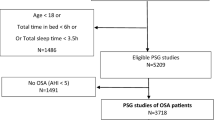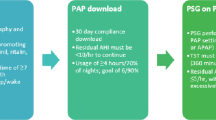Abstract
Purpose
Patients with obstructive sleep apnea (OSA) may experience apneas and hypopneas primarily during stage R (REM) sleep when end-expiratory lung volume (EELV) reaches its nadir. The purpose of this study was to determine if REM-related reductions in EELV persist in the presence of continuous positive airway pressure (CPAP) prescribed during non-stage REM (NREM) sleep.
Methods
We prospectively recruited 17 subjects referred to the sleep laboratory for CPAP titration. CPAP was titrated per AASM protocol to control respiratory events. The change in EELV was measured using magnetometry.
Results
Of the 17 subjects, 12 (71%) had moderate to severe OSA. Despite the application of CPAP, there was a significant reduction in EELV between NREM and REM sleep (− 105.9 ± 92.2 to − 325.0 ± 113.1 mL, respectively, p < 0.01). The change in EELV between non-stage R (NREM) and REM significantly correlated with overall apnea-hypopnea index (AHI) (r = 0.5, p = 0.04), the number of respiratory arousals during REM (r = 0.5, p = 0.04), and prescribed level of CPAP (r = 0.7, p < 0.01).
Conclusion
REM-related reductions in EELV are associated with worsening sleep disordered breathing and occur despite the presence of CPAP.




Similar content being viewed by others
Abbreviations
- AASM:
-
American Academy of Sleep Medicine
- Ab:
-
Abdomen
- AHI:
-
Apnea-hypopnea index
- auto CPAP:
-
An automatic titrating CPAP device
- BMI:
-
Body mass index
- CPAP:
-
Continuous positive airway
- ΔEELV:
-
Change in end-expiratory lung volume
- EELV:
-
End-expiratory lung volume
- FRC:
-
Functional residual capacity
- NREM:
-
Non-stage R sleep
- OSA:
-
Obstructive sleep apnea
- Pcrit:
-
Pharyngeal critical pressure
- PSG:
-
Polysomnography
- RC:
-
Rib cage
- REM:
-
Stage R/rapid eye movement sleep
- SDB:
-
Sleep-disordered breathing
- Stage R:
-
REM sleep
- VT:
-
Tidal volume
- Xi:
-
Axial displacement
References
Hudgel DW, Devadatta P (1984) Decrease in functional residual capacity during sleep in normal humans. J Appl Physiol 57:1319–1322
Young T, Peppard PE, Gottlieb DJ (2002) Epidemiology of obstructive sleep apnea: a population health perspective. Am J Respir Crit Care Med 165(9):1217–1239
Marshall NS, Wong KK, Liu PY, Cullen SR, Knuiman MW, Grunstein RR (2008) Sleep apnea as an independent risk factor for all-cause mortality: the Busselton Health Study. Sleep 31(18):1079–1085
Young T, Finn L, Peppard PE, Szkio-Coxe M, Austin D, Nieto FJ, Stubbs R, Hla KM (2008) Sleep disordered breathing and mortality: eighteen-year follow-up of the Wisconsin sleep cohort. Sleep 31(8):1071–1078
Gay P, Weaver T, Loube D, Iber C (2006) Evaluation of positive airway pressure treatment for sleep related breathing disorders in adults. Sleep 29(3):381–401
Koo P, Gartman EJ, Sethi JM, Kawar E, McCool FD (2017) Changes in end-expiratory lung volume during sleep in patients at risk for obstructive sleep apnea. J Clin Sleep Med 13(8):941–947
Squier SB, Patil SP, Schneider H, Kirkness P, Smith PL, Schwartz AR (2010) Effect of end-expiratory lung volume on upper airway collapsibility in sleeping men and women. J Appl Physiol 109(4):977–985
Neilly JB, Gaipa EA, Maislin G, Pack AI (1991) Ventilation during early and late rapid-eye-movement sleep in normal humans. J Appl Physiol 71(4):1201–1215
McCool FD, Wang J, Ebi KL (2002) Tidal volume and respiratory timing derived from a portable ventilation monitor. Chest 122(2):684–691
Wagner J, Clausen JL, Coates A et al (2005) Standardisation of the measurement of lung volumes. Eur Respir J 26(3):511–522
Penzel T, Wessel N, Riedl M, Kantelhardt JW, Rostig S, Glos M, Suhrbier A, Malberg H, Fietze I (2007) Cardiovascular and respiratory dynamics during normal and pathological sleep. Chaos 17:015116. https://doi.org/10.1063/1.2711282
Heinzer RC, Stanchina ML, Malhotra A, Jordan AS, Patel SR, Lo YL, Wellman A, Schory K, Dover L, White DP (2006) Effect of increased lung volume on sleep disordered breathing in patients with sleep apnoea. Thorax 61(5):435–439
Jones RL, Nzekwu MM (2006) The effects of body mass index on lung volumes. Chest 130(3):827–833
Author information
Authors and Affiliations
Corresponding author
Ethics declarations
All procedures performed in studies involving human participants were in accordance with the ethical standards of the institutional and/or national research committee and with the 1964 Helsinki declaration and its later amendments or comparable ethical standards. Informed consent was obtained from all individual participants included in the study.
All authors have seen and approved the manuscript.
Work for this study was performed at Alpert Medical School of Brown University, Memorial Hospital of Rhode Island.
Conflict of interest
The authors declare that they have no conflict of interests.
Additional information
Publisher’s note
Springer Nature remains neutral with regard to jurisdictional claims in published maps and institutional affiliations.
Rights and permissions
About this article
Cite this article
Koo, P., Gartman, E.J., Sethi, J.M. et al. End-expiratory lung volume decreases during REM sleep despite continuous positive airway pressure. Sleep Breath 24, 119–125 (2020). https://doi.org/10.1007/s11325-019-01857-9
Received:
Revised:
Accepted:
Published:
Issue Date:
DOI: https://doi.org/10.1007/s11325-019-01857-9




